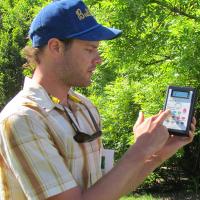
Research Focus:
Remote sensing of crop structure and function
Research Abstract:
Remotely sensed data that are sensitive to rapidly changing plant physiology can provide real-time information about crop responses to abiotic conditions. The Photochemical Reflectance Index (PRI) has shown promise when measured at short timesteps to remotely estimate dynamics in xanthophyll pigment interconversion — a plant photoprotective mechanism that results in lowered photosynthetic efficiency. To gain a better understanding of this dynamic spectral response to environmental conditions, we investigated PRI over two seasons (2013 and 2014) in rainfed soft white spring wheat (Triticum aestivum L.). Highly temporally resolved (measurement frequency = five minutes) in-situ radiometric measurements of PRI were collected at field plots of varying nitrogen (N) and soil water conditions (n = 16). To represent the diurnal magnitude of xanthophyll pigment interconversion, we use a delta PRI (ΔPRI) derived from a midday PRI (xanthophyll de-epoxidation state) and an early morning PRI (xanthophyll epoxidation state). We hypothesize that ΔPRI can empirically deconvolve the diurnally changing (facultative) from the seasonally changing (constitutive) component of the PRI signal. In this study, ΔPRI demonstrated less sensitivity than an uncorrected PRI to leaf area index (LAI) and leaf chlorophyll content throughout the growing season. ΔPRI was correlated with continuous, unattended crop responses associated with vapor pressure deficit (0.50 > R2 > 0.48), stomatal conductance (R2 = 0.47), and air temperature (0.42 > R2 > 35). Further, the sensitivity with which ΔPRI responded to solar radiation under varying N treatments and periods of soil water availability (surplus, depletion, and deficit) suggests that crop growth may be inhibited by a xanthophyll cycle mediated stress response, detectable by ΔPRI. A major implication of these findings is that highly temporally and spatially resolved ΔPRI data could be used to track plant status in response to changing environmental conditions.
Publications and Presentations:
Magney, T.S., Eitel, J.U.H., Huggins, D.R. and Vierling, L.A. 2016. Proximal NDVI Derived Phenology Improves in-Season Predictions of Wheat Quantity and Quality. Agricultural and Forest Meteorology 217:46–60.
Boelman, N., Holbrook, J.D., Krause, J., Chmura, H., Magney, T., Perez, J., Eitel, J., Gough, L., Vierling, K., Wingfield, J., Vierling, L. 2016. Airborne laser scanning and spectral remote sensing give a bird's eye perspective on arctic tundra breeding habitat at multiple spatial scales. Remote Sensing of Environment. 184:337-349.
Greaves, H., Vierling, L., Eitel, J., Boelman, N., Magney, T. Prager, C. Griffin, K. 2016. High-resolution mapping of aboveground shrub biomass in Arctic tundra using airborne lidar and imagery. Remote Sensing of Environment. 184:361-373.
Magney, T., Veirling, L., Eitel, J., Huggins, D., Garrity, S. 2016. Response of high frequency Photochemical Reflectance Index (PRI) measurements to environmental conditions in wheat. Remote Sensing of Environment. 173:84-97.
Gasch, C., Hengl, T., Graker, B., Meyer, H., Magney, T., Brown, D. 2015. Spatio-temporal interpolation of soil water, temperature, and electrical conductivity in 3D + T: The Cook Agronomy Farm data set. Spatial Statistics. 14: 70-90.

